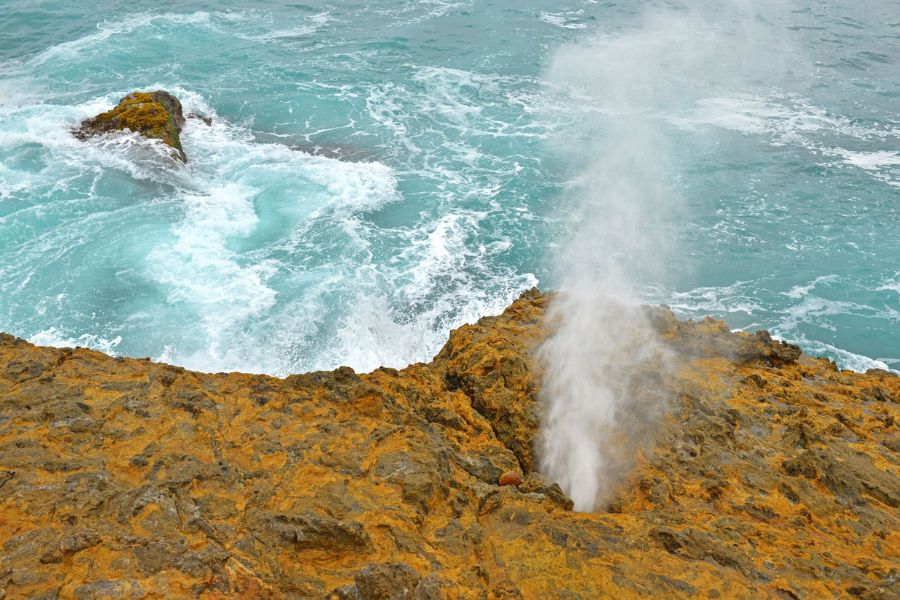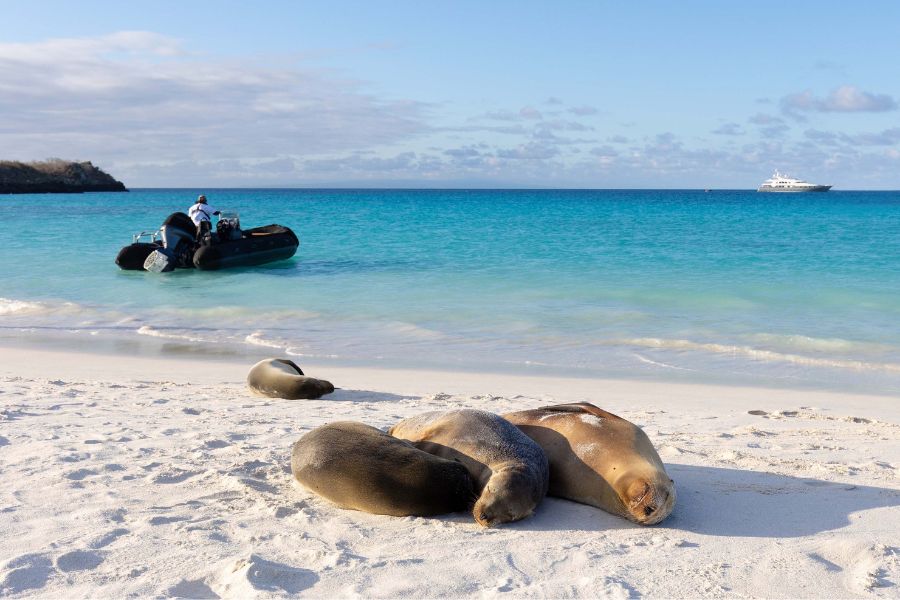
Espanola Island
Espanola Island is often regarded as one of the most interesting of the Galapagos Islands due to its high percentage of endemic fauna. Explorers visiting this island can expect up close encounters with Espanola mockingbirds, lava lizards, marine iguanas, sea lions, giant tortoises, and the very rare waved albatross.
Espanola, the oldest of the Galapagos Islands, is found at the southernmost tip of the archipelago. It is a classic shield volcano created from a single caldera at the center of the Island. Thousands of years of erosion has made Espanola the flattest in the region with very minimal elevation. The climate is extremely dry and features a mix of arid and transitional habitats. On the sixth day of Aqua Expeditions’ Easy Galapagos itinerary guests will visit its two main visitor sites; Punta Suarez, a bird watcher’s paradise; and Bahia Gardner, a 2 kilometer stretch of white coralline beach home to playful sea lions and teeming with marine life.
Punta Suarez
A visit to Punta Suarez begins with a dry landing near a small lighthouse followed by a 3 kilometer hike through bird heaven. First, explorers stroll along a sandy beach populated with friendly sea lions. If you are lucky, you may even chance upon the elusive Galapagos Hawk soaring the skies above. As the trail progresses through the rocky maze, visitors are guaranteed to spot blue-footed boobies, Nazca boobies, red-billed tropic birds, red-and-green marine iguanas (sometimes referred to as ‘Christmas Iguanas’) and many other endemic creatures.
Once through the meandering trail, you’ll arrive at an open plain 15 meters above the crashing sea. This is the only place on the planet where 20,000 pairs of Waved Albatrosses come to nest and breed every year between April and December. These birds are the largest in the Galapagos Archipelago, with an average wingspan of 2.5 meters and weighing up to 5kg.

At the far end of the plateau, soak up splendid views across the black cliffs, open ocean, and the ‘El Soplador’ blowhole — a volcanic formation that projects seawater 25 meters into the air.

Bahia Gardner

Bahia Gardner, known as Gardner Bay in English, is Espanola Island’s second visitor site. It has been voted as one of the top 20 beaches in the world by CNN and it is not hard to see why. This 2 kilometer stretch of white coral sand beach is soft under-foot and features crystal-clear calm waters — perfect for an afternoon of sunbathing, swimming, and snorkeling.
Osborn Islet

Just a stone’s throw from Gardner Bay lies a beautiful array of islets, one of which is Osborn Islet. Only accessible by panga, the waters here are calm and perfect for swimming or snorkeling. Beneath the water’s surface, a world of vibrant tropical fish can be found including angel fish, parrot fish, and butterfly fish. It is also likely that you will spot white-tipped reef sharks, green pencil urchins, and manta rays.
Where do we go next?
When exploring the Galapagos Archipelago with Aqua Expeditions on board the Aqua Mare, Espanola Island is visited on our East Galapagos Itinerary. After a relaxing day of bird watching, sun bathing, and snorkeling, guests will return to the 50-meter superyacht to enjoy an extra special Aqua Bloody Mary under starry-skies as we make way to our next destination — Santa Fe and South Plaza Islands.

Sante Fe is also known as Barrington Island, named after British Admiral Samuel Barrington. This small (24 square kilometers), arid, and relatively flat island is thought to be nearly four million years old. Located on the island’s northeastern shore is our first landing point, Barrington Bay, a picturesque sandy beach populated by a large colony of friendly sea lions.
After lunch on board Aqua Mare, we sail to South Plaza Island for the second half of the day.

About 15 miles of the east coast of Santa Cruz, lies South Plaza Island — one of two crescent-shaped islands known as the Plazas. Unique to South Plaza is its richly hued sesuvium fields and elusive hybrid iguana (half land, half marine iguana). The island is made up of various habitats including white sandy beaches, arid shrubland, cacti forests, and steep cliffs — all of which will be thoroughly explored alongside Aqua Expeditions’ expert naturalist guides.
Book an expedition on Aqua Mare to discover the elusive wildlife and dramatic volcanic landscapes of the Galapagos Archipelago. Curated with exclusivity and personalized service enabled in mind, the yacht is the only one in the Galapagos Islands to have a one-to-one crew to guest ratio. Plan your trip now and feel free to reach out to our Expeditions Consultant with any questions you may have.



